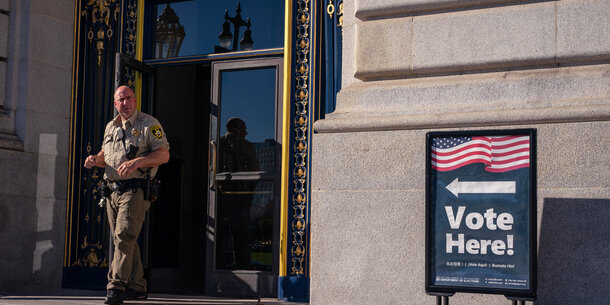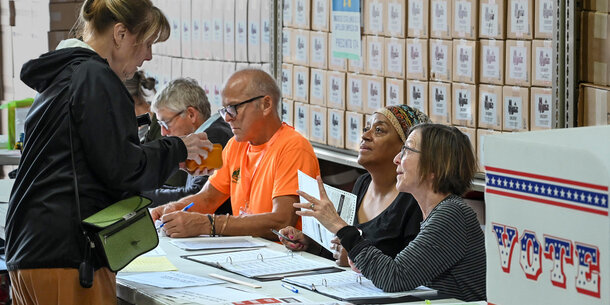How the Brennan Center arrived at its $44 million to $73 million estimate for bulletproofing election offices
We estimate that on average, bullet resistant protections for election offices — which may include barriers for customer transaction counters, reinforcements for interior and exterior doors, and bullet resistant exterior windows — will cost $3,000–$5,000 for the smallest offices and $20,000–$30,000 for the largest offices. Costs could vary considerably depending on the size, layout, and age of election offices, other public functions that the office building serves, specific threats, and existing bullet-resistant barriers in place. We used publicly available information from vendors and local government office renovations to inform these estimates.1
We used Democracy Fund’s “Stewards of Democracy” report and EAVS 2020 data to estimate how many jurisdictions have a given number of full-time employees.2 We assumed that jurisdictions with zero to one full-time employees (3,987 jurisdictions) would need $3,000–$5,000 to install bullet resistant barriers; jurisdictions with two to five full-time employees (2,928 jurisdictions) would need $5,000–$10,000; jurisdictions with 6 to 10 full-time employees (533 jurisdictions) would need $15,000–$20,000; and jurisdictions with 10 or more full-time employees (450 jurisdictions) would need $20,000–$30,000. We multiplied these to arrive at a total estimated range of $43,596,000–$73,375,000.
How the Brennan Center arrived at its $95 million estimate for panic alarm systems
We estimate that on average, panic buttons for election offices will cost $1,000 per device over a five-year span and that GPS-enabled panic buttons for precincts (which will not be used as often throughout the year) will cost $495 per device over a five-year span. We used publicly available information and conversations with vendors to inform these estimates.3
We used EAVS 2020 data to determine the total precincts on Election Day (176,933) and the total number of election offices (7,898) and multiplied each by the cost per device to arrive at a total estimate of $95,479,835.
How the Brennan Center arrived at its $75 million estimate for RFID key card access control systems
We estimate that on average, key cards cost $8 per user; readers, locks, and other hardware cost $1,250 per door; access control system subscriptions and maintenance costs $1,800 per door over five years; and that the total cost per door is $3,050.4 We assumed that jurisdictions with zero to one full-time employee would have three doors that require access controls and two key card users; jurisdictions with two to five full-time employees would have three doors and three users; jurisdictions with 6 to 10 full-time employees would have three doors and five users; and jurisdictions with more than 10 full-time employees would have five doors and 10 users.
We multiplied the total cost per jurisdiction by the number of jurisdictions with no full-time employees (2,644), one full-time employee (1,343), two to five full-time employees (2,928), 6 to 10 full-time employees (533), and more than 10 full-time employees (450). We added these to arrive at a total estimate of $75,191,123.
How the Brennan Center arrived at its $27 million estimate for camera surveillance
We estimate that the average camera costs $750 and that the cost of data storage over five years is $600.5 We assumed that jurisdictions with zero to one full-time employees would need two cameras; jurisdictions with 2 to 10 full-time employees would need five cameras; and jurisdictions with 10 or more full-time employees would need 10 cameras. We multiplied the number of jurisdictions in each group by the per office costs to arrive at a total estimate of $27,073,050.
How the Brennan Center arrived at its $50 million estimate for personal identifiable information protection
We estimate that the cost per person for personal identifiable information protection is $5,500 if the election office covers one individual and $5,000 if the office covers two or more individuals.6 We assumed that jurisdictions with zero to five full-time employees (6,915 jurisdictions) would have one person covered; jurisdictions with 6 to 10 full-time employees (533 jurisdictions) would have two people covered; and jurisdictions with 2 or more full-time employees (450 jurisdictions) would have three people covered. We multiplied the number of jurisdictions in each group by the per office costs to arrive at a total estimate of $50,112,500.
Endnotes
-
1
Total Security Solutions, “6 Questions About Building Physical Security & Bulletproofing,” September 12, 2019, https://www.tssbulletproof.com/blog/bulletproofing-physical-security/; Total Security Solutions, “Uses and Costs for Security Window Film and Bulletproof Glass,” October 24, 2018, https://www.tssbulletproof.com/blog/costs-security-window-film/; Manistee, MI, FY 2023–2028 Capital Improvement Plan, Municipal Capital Projects, http://www.manisteemi.gov/ArchiveCenter/ViewFile/Item/4674 (Budgeting $25,000 to install bullet resistant glass in the Police Department, Clerk and Treasurer’s offices); Zeeland, MI, 2021–22 Fiscal Year Budget–Capital Improvement Program, https://www.cityofzeeland.com/DocumentCenter/View/6973/2021–2022-Requested-Budget- (Budgeting $20,000 for bulletproof glass in exterior windows of public safety building). -
2
Jurisdiction size estimates based on data from EAVS 2020. U.S. Election Assistance Commission, “Studies and Reports,” last accessed March 7, 2022, https://www.eac.gov/research-and-data/studies-and-reports; and Natalie Adona et al., “Stewards of Democracy,” Democracy Fund, 2019, https://democracyfund.org/wp-content/uploads/2020/06/2019_DemocracyFund_StewardsOfDemocracy.pdf. -
3
See, e.g., General Services Administration, Authorized Federal Supply Schedule Pricelist, Response Technologies, Ltd., https://www.gsaadvantage.gov/ref_text/GS07F030GA/0VAQND.3R13M4_GS-07F-030GA_RTGSATCPL4120.PDF. -
4
For typical costs of key card access control systems, see, e.g., Bernhard Mehl, “Access Control Systems Cost: Installation and Price per Door,” kisi blog, February 25, 2021, https://www.getkisi.com/blog/breakdown-of-access-control-system-installation-costs; Brian Rhodes, “Designing Access Control Guide,” internet Protocol Video Market, January 30, 2019, https://ipvm.com/reports/designing-an-access-control-system; Ackerman Security, “Average Cost per Door for Access Control,” last accessed March 7, 2022 https://www.ackermansecurity.com/blog/business-security/average-cost-access-control; ButterflyMX, “Video Intercom Cost,” last accessed March 7, 2022, https://butterflymx.com/cost/; and Salto Systems, “Home,” last accessed March 7, 2022, https://saltoks.com/. -
5
For typical costs of camera surveillance equipment for government facilities, see, e.g., https://online.ogs.ny.gov/purchase/spg/pdfdocs/3880622844PL_AudioEnhancement.pdf. -
6
Based on unit cost estimates provided by New Mexico Office of the Secretary of State.


